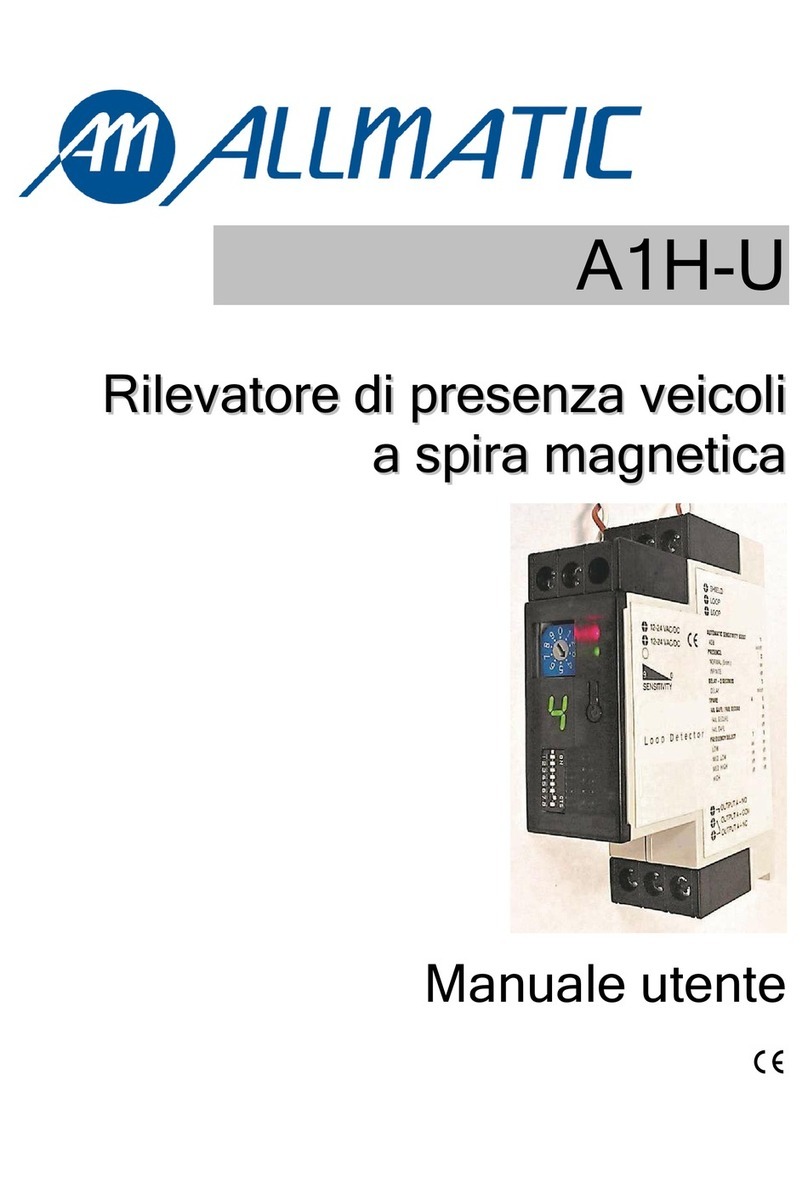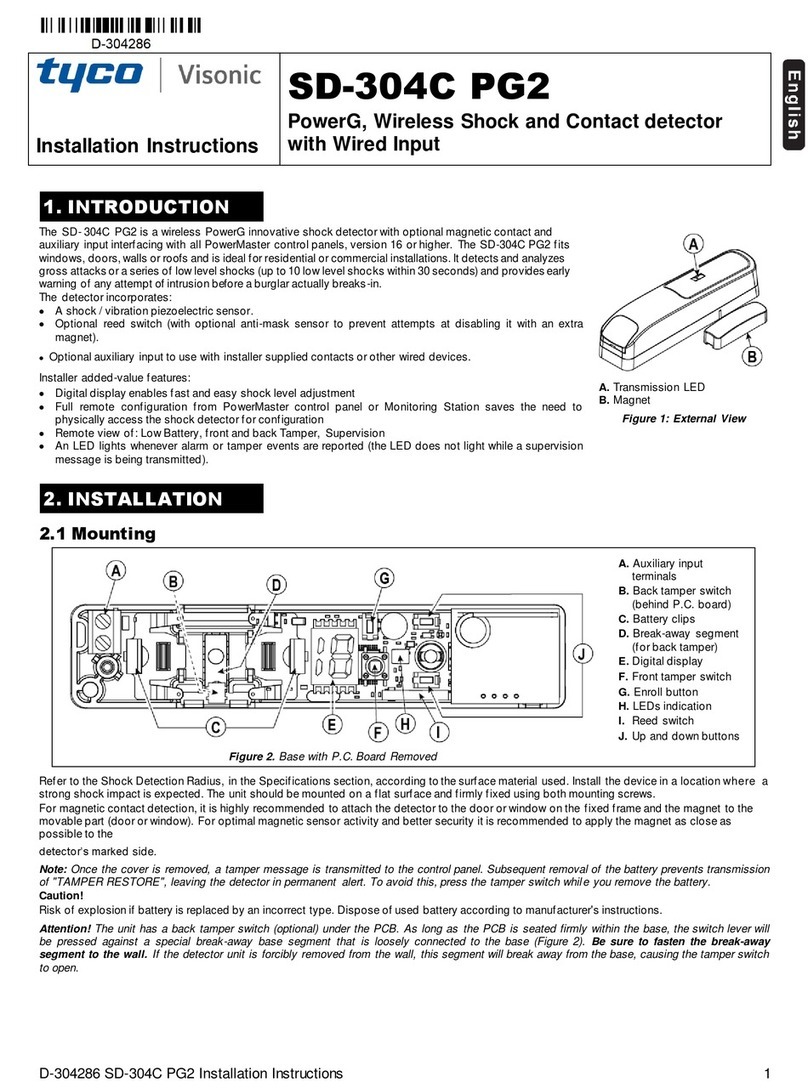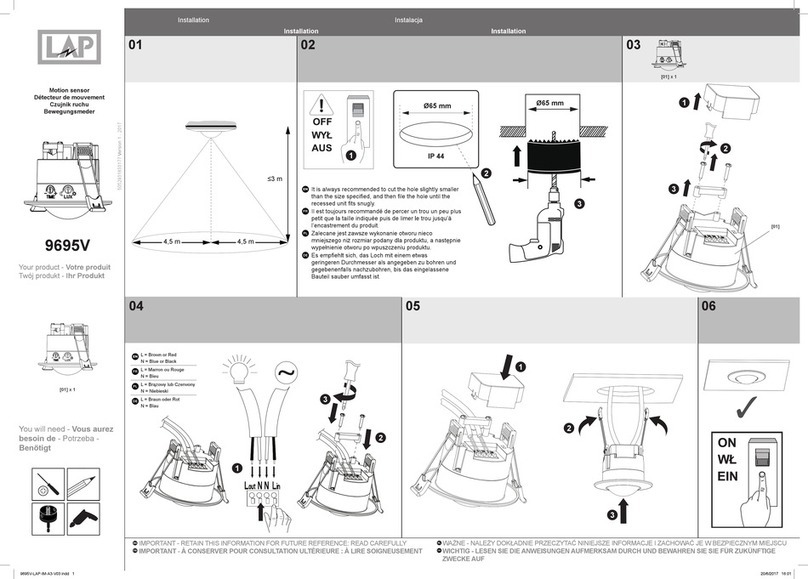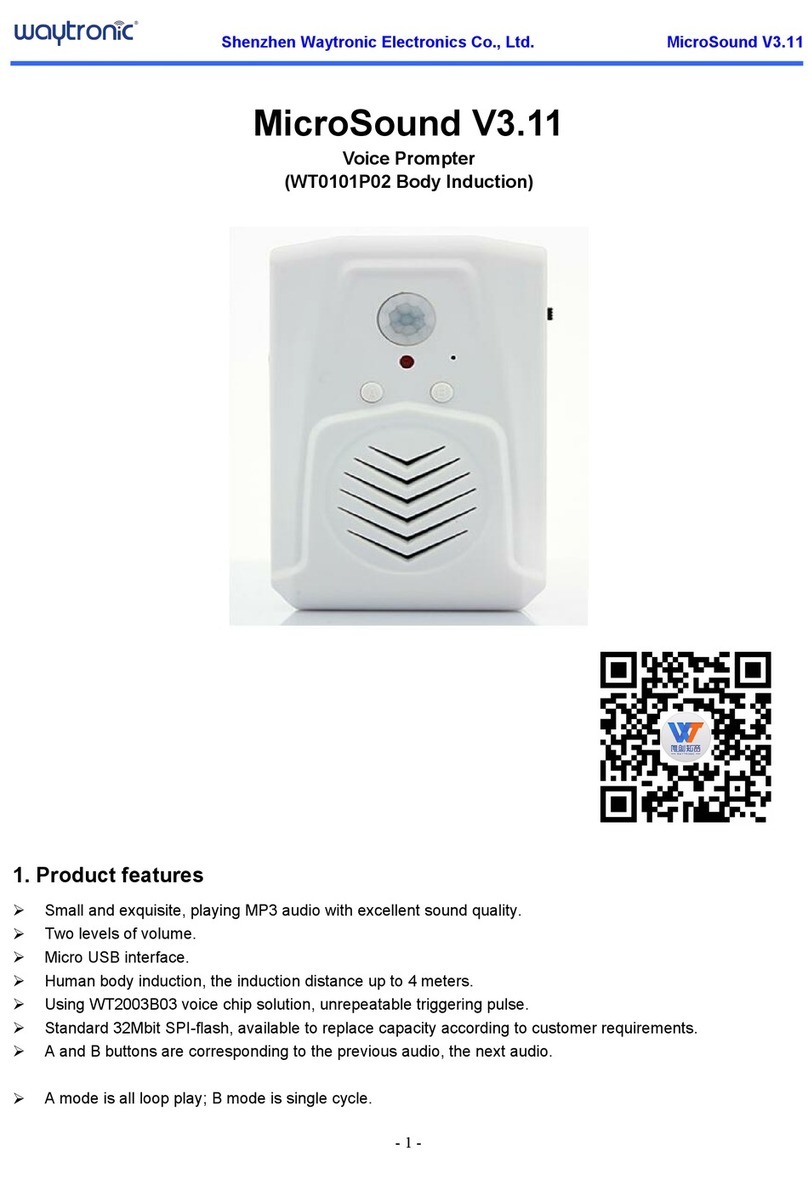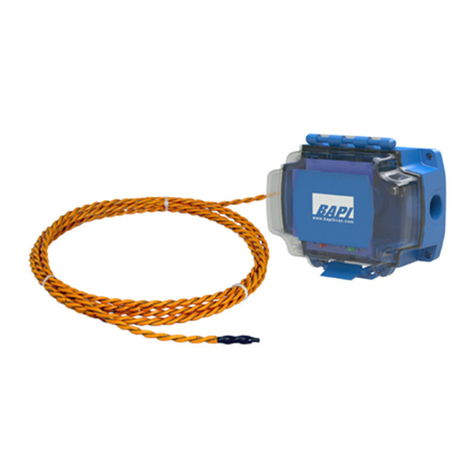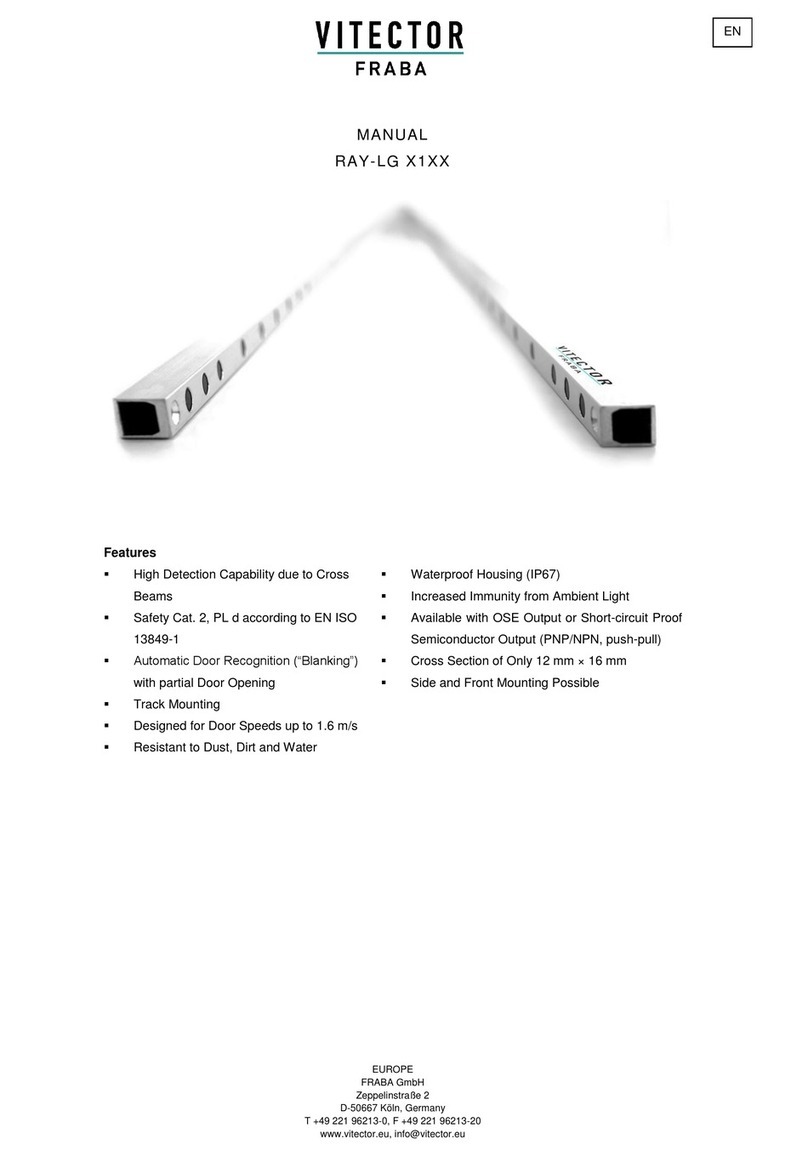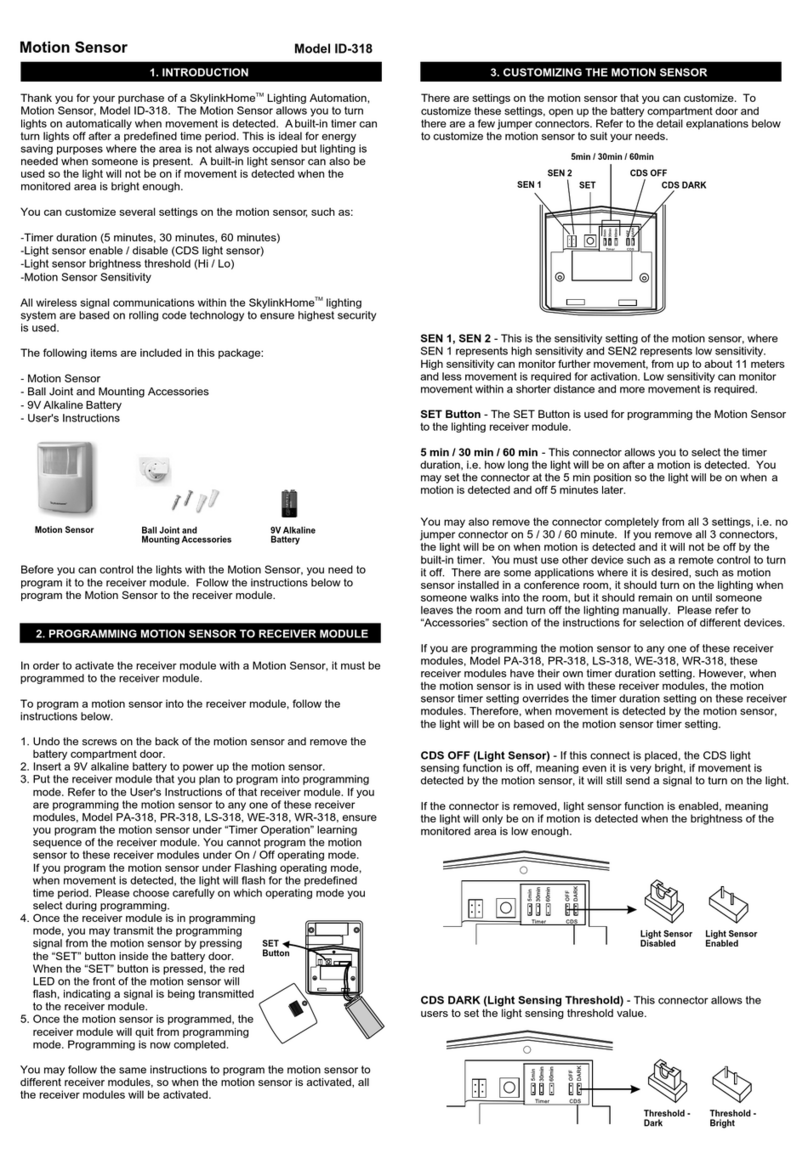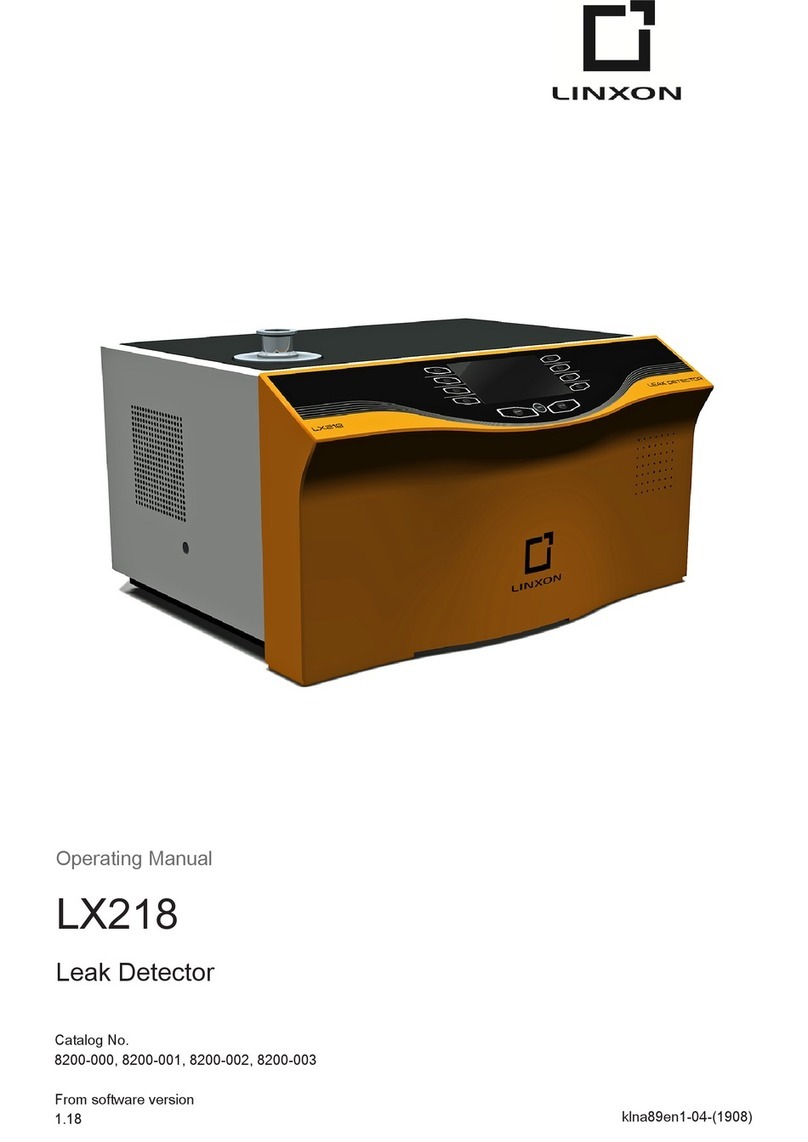Allmatic A1H-U User manual

Loop Detector
Single Loop
DIN rail
ALLMATIC S.R.L. VIA DELL’ ARTIGIANO 1 Z.A., 32026 BORGO VALBELLUNA (BL), ITALY
Instruction manual
Manuel d’instructions
Manuale d’istruzione
Manual de instrucciones
A1H-U

ENGLISH page.......................3
FRANÇAIS page ..................22
ESPAÑOL página .................42
ITALIANO pagina.................62

Rev.00 - 09.2021 | A1H-U Single Loop Detector | © 2021 | Allmatic
3
EN
Table of contents
1. Introduction .............................................................................................................. 4
1.1 Description ..........................................................................................................................4
1.2 Validity of documentation ......................................................................................................4
1.3 Who should use this documentation........................................................................................4
1.4 Use of the product ................................................................................................................4
1.5 Safety precautions................................................................................................................4
1.6 Other documents..................................................................................................................4
2. Product ..................................................................................................................... 5
2.1 Main features.......................................................................................................................5
2.2 Identification number ............................................................................................................5
2.3 Specifications ......................................................................................................................6
3. Wiring diagrams....................................................................................................... 7
4. Structure................................................................................................................... 7
5. LED indications.......................................................................................................... 8
5.1 Power / fault indicator LED....................................................................................................9
5.2 Loop state LED......................................................................................................................9
5.3 Relay state LED.....................................................................................................................9
6. Dip Switch .............................................................................................................. 10
DIP Switch settings....................................................................................................................10
7. Loop installation ..................................................................................................... 14
7.1 Dimension and placement of the loop ...................................................................................14
7.2 Inductance and loop turns.. .................................................................................................15
7.3 Loop wire material..............................................................................................................16
7.4 Feeder cable......................................................................................................................17
7.5 Ground Installation .............................................................................................................17
8. Product Setup Guide ............................................................................................... 18
8.1 Channel Selection ..............................................................................................................18
8.2 Sensitivity adjustment ..........................................................................................................19
8.3 Automatic Sensitivity Boost (ASB)..........................................................................................20
8.4 Fail Safe and Fail Secure mode............................................................................................21

Rev.00 - 09.2021 | A1H-U Single Loop Detector | © 2021 | Allmatic
4
EN
1. Introduction
This manual is a reference guide for Allmatic Loop Detector A1H-U. It describes the product specifications
as well as how to install, set up and use the product for its intended use.
1.2 Validity of documentation
This manual is valid only for A1H-U Loop Detector and until any newer documentation is published.
This instruction manual describes the functions, operations and installation of the product for its intended
use.
1.6 Other documents
It is possible to find the datasheet, manuals, brochures and electrical drawings on the Internet at
http://www.allmatic.com
1.5 Safety precautions
This Loop Detector must not be used in applications where personal safety depends on the function of the Loop
Detector.
Installation and use must be carried out by trained technical personnel with basic electrical installation knowledge.
The installer is responsible for correct installation according to local safety regulations and must ensure that a
defective Loop Detector will not result in any hazard to people or equipment. If the Loop Detector is defective, it
must be replaced and secured against unauthorized use.
1.3 Who should use this documentation
This manual contains important information regarding installation and must be read and completely
understood by specialized personnel dealing with these kinds of devices.
We highly recommend that you read the manual carefully before installing the Loop Detector. Please save
the manual for future use. The installation manual is intended solely for qualified technical personnel.
1.4 Use of the product
The Loop Detector is primarily used to detect vehicles such as cars, trucks, buses and others.
A loop in the ground is required for the Loop Detector to detect any vehicles above the loop. The device
works on the same principle of an inductive sensor; utilizing the phenomenon of eddy current. When a
metal target/vehicle approaches on top of the loop, the magnetic field generated by the loop interacts with
the target and makes the Loop Detector to change its output.
The Loop Detector can be used at carpark barriers, bollards, gates, toll gantries and many other door
access applications.
1.1 Description
Allmatic Loop Detectors are devices designed and manufactured in accordance with IEC international
standards and are subject to the Low Voltage (2014/35/EU) and Electromagnetic Compatibility (2014/30/
EU) EC directives.
All rights to this document are reserved by Allmatic Industri: copies may be made for internal use only.
Please do not hesitate informing us to make any suggestions for improving this document.

Rev.00 - 09.2021 | A1H-U Single Loop Detector | © 2021 | Allmatic
5
EN
2. Product
2.1 Main features
• Loop input inductance: 20 μH to 1000 μH
• Adjustable sensitivity in 10 steps: 0.01% to 1.00% via potentiometer
• Automatic loop frequency tuning or manual tuning via 4 adjustable loop frequency channels to
avoid crosstalk
• Automatic Sensitivity Boost (ASB) for high bed vehicle detection
• Selectable fail safe and fail secure mode
• 2 x SPDT relay outputs, selectable operation as pulse or presence switching
• Multicolor power/fault LED indication for easy setup and intuitive diagnostic
• Individual loop state multicolor LED to indicate different loop status and fault
• Loop diagnostic capability: loop short circuit, loop open circuit, inductance out of range,
channel crosstalk
• Directional logic for dual loop
• Wide range power supply: 24-240 VAC/VDC, 45-65 Hz

Rev.00 - 09.2021 | A1H-U Single Loop Detector | © 2021 | Allmatic
6
EN
2.3 Specifications
Loop input inductance 20 μH ... 1000 μH
Adjustable sensitivity 0,01% ... 1,00%
Number of adjustable steps 10
Number of frequency channels 4
Frequency range 10 ... 130 kHz
Loop fault detection Short circuit, open circuit, inductance out of range,
frequency crosstalk
Response time 130 ms
Output type Relay
Number of output 2 x SPDT
Output mode Pulse or presence; selectable via dip switch
Output Assignment 2 x SPDT for loop 1
Rated operational voltage (output) 250 VAC/VDC
Rated operational current (Ie)AC1: 5 A @ 250 VAC
DC1: 1 A @ 30 VDC
Mechanical lifetime 15 x 106
Electrical lifetime >100 000 operations (@5A load)
Protection Reverse polarity and overvoltage
Rated operational voltage (UB) 24 ... 240 VAC/VDC
Power consumption 24 VAC/VDC < 2 W / 2.5 VA
115 VAC/VDC < 2 W / 3 VA
240 VAC/VDC < 2 W / 4 VA
Rated supply frequency 45 to 65 Hz
Rated insulation voltage 800 V
Rated impulse withstand voltage 4 kV (1.2/50 μs)
Power-ON delay (tv)5 s for manual frequency tuning
10 s for automatic frequency tuning
Ambient temperature -40° ... +70°C (-40° ... +158°F) (operating)
-40° ... +70°C (-40° ... +158°F) (storage)
Ambient humidity range 0% ... 90% (operating)
0% ... 90% (storage)
Overvoltage category III (IEC)
Degree of protection IP20 (IEC)
Pollution degree 2 (IEC)
Connection type Screw terminal
Housing material PPO PX9406-802, PPO Noryl SE1
Colour RAL 7035 (Grey)
Dimensions 84 mm (h) x 22 mm (w) x 99 mm (d)
Weight 134 g

Rev.00 - 09.2021 | A1H-U Single Loop Detector | © 2021 | Allmatic
7
EN
3. Wiring diagrams
L11 Loop
L12 Loop
E1 Earth
R21 Relay 2 Normally Open (NO)
R22 Relay 2 Normally Closed (NC)
R23 Relay 2 Common (COM)
R11 Relay 1 Normally Open (NO)
R12 Relay 1 Normally Closed (NC)
R13 Relay 1 Common (COM)
A1 Supply
A2 Supply
1 2 3 45 6 7 8 9 10 11 12
ON
RESET
1
2
3
4567
8
9
10
SENSITIVITY
RELAY 1
LOOP
RELAY 2
1 2 3 45 6 7 8 9 10 11 12
ON 78 CTS
R11 R12 R13
Relay 1
A1 A2
Supply
Relay 2
L11 L12 E1
Loop
R21 R22 R23
4. Structure
Power / Fault LED
Reset button
Loop LED
Relay 1 LED
Relay 2 LED
Dip switch
Potentiometer

Rev.00 - 09.2021 | A1H-U Single Loop Detector | © 2021 | Allmatic
8
EN
Loop state LED
LED colour LED constant LED Flashing
Inductance OK -
Inductance too high Inductance too low
Loop is open circuit Loop is short circuit
Relay state LED
LED colour Mode Relay
deactivated Relay activated
Presence mode LED OFF LED ON
Pulse mode, 0.1 s LED OFF LED ON for 0.5 s
Pulse mode, 0.5 s LED OFF LED ON for 1.0 s
5. LED indications
In general, LDD Loop Detectors have 3 categories of LED indications; namely Power/Fault indicator
LED, Loop state LED and Relay state LED:
L11L12 E1
R21R22 R23
R11R12 R13
A1 A2 E2
RESET
1
2
3
4567
8
9
10
SENSITIVITY
RELAY 1
LOOP
RELAY 2
123456789101112
ON 78 CTS
Power / fault indicator
LED colour LED constant LED Flashing
All OK (ASB OFF) DIP switch changed, but
changes not in effect
All OK (ASB ON) -
Low signal indication -
Channel crosstalk -
-Indication of the frequency
channel

Rev.00 - 09.2021 | A1H-U Single Loop Detector | © 2021 | Allmatic
9
EN
5.1 Power / fault indicator LED
LED colour LED constant LED Flashing
All OK (ASB OFF) DIP switch changed, but changes not in effect
All OK (ASB ON) -
Low signal indication -
Channel crosstalk -
- Indication of the frequency channel
Explanation:
• Green LED (steady): Unit is powered up and everything is working well
• Green LED (flashing): Dip switch has been changed since power up, but change has not taken
effect. Please press the reset button
• Blue LED (steady): Automatic Sensitivity Boost is turned ON and everything is working well
• Yellow LED (steady): Signal level is low in the loop. It is recommended to increase sensitivity
• Red LED (steady): Crosstalk of loop frequency with another loop detected. Select different frequency
channel on DIP switches and reset product
• White LED (flashing): After start up, the number of times the LED flashes, indicates the frequency
channel selected in both manual and automatic frequency tuning mode (e.g. LED flashes two times
is equivalent to channel 2)
5.2 Loop state LED
Explanation:
• Green LED (steady): Loop inductance is within limit and working well
• Yellow LED (steady): Loop inductance is too high (more than 1000µH)
• Yellow LED (flashing): Loop inductance is too low (less than 20µH)
• Red LED (steady): Loop is open circuit
• Red LED (flashing): Loop is short circuit
LED colour LED constant LED Flashing
Inductance OK -
Inductance too high Inductance too low
Loop is open circuit Loop is short circuit
5.3 Relay state LED
Explanation:
• Yellow LED (off): Relay is not activated
• Yellow LED (steady): Relay is activated and in presence mode
• Yellow LED (on for 0.5 s): Relay is activated and in pulse mode, 0.1 s
• Yellow LED (on for 1.0 s): Relay is activated and in pulse mode, 0.5 s
LED colour Mode Relay deactivated Relay activated
Presence mode LED OFF LED ON
Pulse mode, 0.1 s LED OFF LED ON for 0.5 s
Pulse mode, 0.5 s LED OFF LED ON for 1.0 s

Rev.00 - 09.2021 | A1H-U Single Loop Detector | © 2021 | Allmatic
10
EN
6. Dip Switch
DIP Switch settings
123456789101112
ON
ON
RESET
1
2
3
4567
8
9
10
SENSITIVITY
RELAY 1
LOOP
RELAY 2
123456789101112
ON 78 CTS
DIP SWITCH 1 - Frequency mode selection
The Loop Detector operates on one out of four channels. If the Loop Detector is located near sources
of electrical or magnetic disturbances, e.g. from other Loop Detectors, some channels can be more
advantageous to use than others. Two Loop Detectors placed in close proximity of each other should
use different channels to avoid crosstalk between the loops.
• When DIP SWITCH 1 is set to ON, the user manually selects which channel is used by setting DIP
switch 2 and 3.
Frequency settings
1Selection
mode Automatic channel selection Manual channel selection
2Channel
selection DIP switch 2 and 3 are not used in
automatic channel selection
1 2 3 4
3
General settings
4 Turn-on delay Delay OFF Delay 2.0 sec
5 ASB ASB OFF ASB ON
6 Failure mode Fail safe Fail secure
Relay 1 settings
7 Output mode Pulse mode Presence mode
8 Time 0.1 sec pulse 0.5 sec pulse Infinite 60 min 10 min 1 min
9 Entry / Exit Vehicle entry Vehicle exit
Relay 2 settings
10 Output mode Pulse mode Presence mode
11 Time 0.1 sec pulse 0.5 sec pulse Infinite 60 min 10 min 1 min
12 Entry / Exit Vehicle entry Vehicle exit

Rev.00 - 09.2021 | A1H-U Single Loop Detector | © 2021 | Allmatic
11
EN
• When DIP SWITCH 1 is set to OFF, during startup the Loop Detector automatically measures
disturbances present on all four channels and selects the channel with best signal conditions.
Note that this procedure will be performed every time the Loop Detector is powered up or reset.
The white LED will show which channel has been selected (refer to the Indication Session on page 10)
DIP SWITCH 2 and 3 - Frequency channel selection
These two DIP switches are used to select which channel the Loop Detector should use. The channels
can only be selected when manual channel selection is set on DIP switch 1. When mode is set to
automatic channel selection, DIP switch 2 and 3 do not have any function.
DIP SWITCH 4 - Turn-on delay
The Loop Detector has a Turn-on delay filter which can be enabled to help to avoid false vehicle
detections.
• When DIP SWITCH 4 is set to ON, the Turn-on delay is activated and any detections shorter than
2 seconds will not cause the output to activate. This function is suitable for detection of stationary
or slow moving vehicles.
• When DIP SWITCH 4 is set to OFF, the Turn-on delay is disabled and output has normal response
time. This function is suitable for detection of fast moving vehicles.
DIP SWITCH 5 - Automatically Sensitivity Boost (ASB)
High bed vehicles such as trucks and trailers normally gives a strong signal when the wheel axles are
inside the circumference of the loop. However the signal drops significantly when the loop is between
the wheel axles or between a truck and its trailer. When ASB function is enabled, the sensitivity is
boosted to avoid output deactivation when signal level is reduced, but high bed vehicle is still on top
of the loop.
• When DIP SWITCH 5 is set to ON, the ASB function is active and sensitivity is boosted to avoid
false deactivations. This mode is recommended for applications where detection of trucks and other
high bed vehicles is needed.
• When DIP SWITCH 5 is set to OFF, the Loop Detector uses normal sensitivity levels. This mode is
recommended for detection of normal cars, vans etc. with low bed height.
DIP SWITCH 6 - Failure mode
This function determines the state of the output relays, both during normal operation and when a failure
is detected in the system.
Note: When Fail Safe mode is selected, the operation of both output relays will be inverted. This
means that the Normally Open (NO) contact will become a Normally Closed (NC) contact and the
Normally Closed (NC) contact will become a Normally Open (NO) contact.
DIP
switch Frequency Channel 1 Frequency Channel 2 Frequency Channel 3 Frequency Channel 4
2OFF ON OFF ON
3OFF OFF ON ON

Rev.00 - 09.2021 | A1H-U Single Loop Detector | © 2021 | Allmatic
12
EN
• When DIP SWITCH 6 is set to ON, the product will operate in FAIL SECURE mode. In case of a
failure on the Loop Detector, in the loop wire or loss of power, the outputs will indicate no detection
of a vehicle.
• When DIP SWITCH 6 is set to OFF, the product will operate in FAIL SAFE mode. In case of a failure
on the Loop Detector, in the loop wire or loss of power, the outputs will indicate detection of a vehicle.
DIP SWITCH 7 - Output mode for relay 1
This setting determines how relay 1 should indicate a vehicle detection in the loop. The Loop Detector
can generate a single pulse, each time a vehicle enters or leaves the loop (Pulse mode). Alternatively
the output can be keept activate as long as there is a vehicle present inside the loop (Presence mode).
• When DIP SWITCH 7 is set to ON relay 1 operates in Presence mode and output is activated as
long as a vehicle is present inside the loop.
• When DIP SWITCH 7 is set to OFF relay 1 operates in Pulse mode and generates a pulse each time
a vehicle enters or leaves the loop.
Note: DIP switch 8 and 9 will have different functionality depending if product is set to operate in
Pulse or Presence mode on DIP switch 7.
DIP SWITCH 8 - Time setting for relay 1 (only for Pulse mode)
When the Loop Detector is operating in Pulse mode (see DIP switch 7), the pulse length can be changed
with DIP switch 8.
• When DIP SWITCH 8 is set to ON relay 1 creates a pulse with a duration of 0.5 s for each
activation.
• When DIP SWITCH 8 is set to OFF relay 1 creates a pulse with a duration of 0.1 s for each
activation.
DIP SWITCH 9 - Entry or Exit mode for relay 1 (only for Pulse mode)
When the Loop Detector is operating in Pulse mode (see DIP switch 7), the output pulse can be
generated either when a vehicle enters the loop or when a vehicle exits the loop. This is selected by
DIP switch 9.
• When DIP SWITCH 9 is set to ON relay 1 creates a pulse each time a vehicle exits the loop.
• When DIP SWITCH 9 is set to OFF relay 1 creates a pulse each time a vehicle enters the loop.
DIP SWITCH 8 & 9 - Timeout setting for relay 1 (only for Presence mode)
When relay 1 is operated in Presence mode (see DIP switch 7), a timeout can be set to limit maximum
activation time of a single vehicle detection. If timeout is set different from infinite, the output will
automatically deactivate, if a vehicle has been constantly detected for longer time than set by DIP
switch 8 and 9.
DIP
switch Infinite 1 hour 10 minutes 1 minute
8OFF ON OFF ON
9OFF OFF ON ON

Rev.00 - 09.2021 | A1H-U Single Loop Detector | © 2021 | Allmatic
13
EN
DIP SWITCH 10 - Output mode for relay 2
This setting determines how relay 2 should indicate a vehicle detection in the loop. The Loop Detector
can generate a single pulse each time a vehicle enters or leaves the loop (Pulse mode). Alternatively
the output can be keept activate as long as there is a vehicle present inside the loop (Presence mode).
• When DIP SWITCH 10 is set to ON relay 2 operates in Presence mode and output is activate as
long as a vehicle is present inside the loop.
• When DIP SWITCH 10 is set to OFF relay 2 operates in Pulse mode and generates a pulse each
time a vehicle enters or leaves the loop.
Note: DIP switch 11 and 12 will have different functionality depending if product is set to operate
in Pulse or Presence mode on DIP switch 10.
DIP SWITCH 11 - Time setting for relay 2 (only for Pulse mode)
When the Loop Detector is operated in Pulse mode (see DIP switch 10), the pulse length can be
changed with DIP switch 11.
• When DIP SWITCH 11 is set to ON relay 2 creates a pulse with a duration of 0.5 s for each
activation.
• When DIP SWITCH 11 is set to OFF relay 2 creates a pulse with a duration of 0.1 s for each
activation.
DIP SWITCH 12 - Entry or Exit mode for relay 2 (only for Pulse mode)
When the Loop Detector is operated in Pulse mode (see DIP switch 10), the output pulse can be
generated either when a vehicle enters the loop or when a vehicle exits the loop. This is selected with
DIP switch 12.
• When DIP SWITCH 12 is set to ON relay 2 creates a pulse each time a vehicle exits the loop.
• When DIP SWITCH 12 is set to OFF relay 2 creates a pulse each time a vehicle enters the loop.
DIP SWITCH 11 & 12 - Timeout setting for relay 2 (only for Presence mode)
When relay 2 is operated in Presence mode (see DIP switch 10), a timeout can be set to limit maximum
activation time of a single vehicle detection. If timeout is set different from infinite, the output will
automatically deactivate, if a vehicle has been constantly detected for longer time than set by DIP
switch 11 and 12.
DIP
switch Infinite 1 hour 10 minutes 1 minute
11 OFF ON OFF ON
12 OFF OFF ON ON

Rev.00 - 09.2021 | A1H-U Single Loop Detector | © 2021 | Allmatic
14
EN
30 cm
1 foot
45º
45º
45º
45º
b
a
30 cm
1 foot
30 cm
1 foot
45º
45º
45º
45º
b
a
30 cm
1 foot
Road curb
Road curb
L11 L12 E1
R21 R22 R23
R11 R12 R13
A1 A2 E2
RESET
1
2
3
4567
8
9
10
SENSITIVITY
RELAY1
LOOP
RELAY2
1 2 3 45 6 7 8 9 10 11 12
ON 78 CTS
L11 L12 E1
R21 R22 R23
R11 R12 R13
A1 A2 E2
RESET
1
2
3
4567
8
9
10
SENSITIVITY
RELAY1
LOOP
RELAY2
1 2 3 45 6 7 8 9 10 11 12
ON 78 CTS
7. Loop installation
7.1. Dimension and placement of the loop
A proper installation of the loop in the road, is the single most important factor for achieving a reliable
detector system. Most detection issues are caused by improper loop installation. Please read the
guidelines below carefully to ensure best possible performance in the application.
If a new loop is installed in an existing application, it is recommended to remove any old loop wire
left in the ground.
The first thing to consider when installing a new loop is the dimension and placement. The dimension of
the loop is dependent on the road size and is normally rectangular in shape with chamfered corners.
The loop should be placed with approximately 30 cm (1 foot) distance to the edge of the road and
other road lanes. This helps to prevent false detections caused by traffic passing in adjacent traffic
lanes.
To reduce stress on the cable and thereby prolong its service life, it is important to avoid sharp bending
of the cable. This is done by cutting a groove at 45 degree angles in each corner. To achieve optimal
signal conditions, the width of the loop (a) should be approximately the same as the width of the
vehicle. In most applications, the dimension of vehicles often varies, in this case it is recommended to
install a loop, which is wider than a typical vehicle and match the width of the road. It is possible to
detect vehicles with a narrow loop, but this reduces signal strength.
Track width
Favourable Unfavourable Unfavourable
Excellent signal Good signal Reduced signal

Rev.00 - 09.2021 | A1H-U Single Loop Detector | © 2021 | Allmatic
15
EN
Minimum
Loop Length (b) Maximum vehicle
speed Minimum
Loop Length (b) Maximum vehicle
speed
0.25 meter 75 km/h 0.8 feet 47 mph
0.50 meter 80 km/h 1.6 feet 50 mph
1.00 meter 95 km/h 3.3 feet 59 mph
2.00 meter 120 km/h 6.6 feet 75 mph
5.00 meter 200 km/h 16.4 feet 124 mph
When the Loop Detector powers up or is
reset, it automatically tunes to its surrounding
environment. This means that stationary metal
objects such as poles, cabinets and grates
do not affect the Loop Detector. It is however
important to ensure a safe distance between
the loops and such moving metal objects, e.g.,
gates. In applications where there are moving
metal objects, it is important to ensure minimum
distance of 1 meter (3.3 feet) between the loop
and the object. Otherwise this can affect the
loop and cause false detections.
The length of the loop (b) influences the maximum
speed at which a vehicle can be traveling
and still be detected. For applications where
detection of high speed vehicles is needed, it
is important to consider this length. The table below shows relation between loop length (b) and
maximum vehicle speed. The table below assumes correct adjustment of the Loop Detector sensitivity
and a minimum vehicle length of 2.5 meters.
7.2. Inductance and loop turns
To achieve the most stable application, it is recommended to install a loop with inductance higher
than 80 µH. Keeping above this inductance will create optimal conditions for detection of vehicles. In
applications where it is impossible or inconvenient to achieve this inductance, a lower number of turns
in the loop can be used. In this case it is however required to stay above minimum inductance of 20 µH
and aim should still be to get as close as possible to 80 µH. The number of turns needed in the loop,
is depending on the circumference. See table below for guidance.
Loop circumference 1) Recommended turns (80 µH) Minimum turns (20 µH)
2 meter (6.6 feet) 13 9
5 meter (16.4 feet) 7 5
6 - 7 meter (19.7 - 23 feet) 6 4
8 - 9 meter (26.2 - 29.5 feet) 5 3
10 - 14 meter (32.8 - 45.9 feet) 4 3
15 - 23 meter (49.2 - 75.5 feet) 3 2
24 - 30 meter (78.7 - 98.4 feet) 2 1
1) Loop circumference = 2 x a + 2 x b.
Loop
min. 1 m
3.3 feet

Rev.00 - 09.2021 | A1H-U Single Loop Detector | © 2021 | Allmatic
16
EN
When installing multiple turns in the loop, it is recommended to place the wires like shown in figure
below.
The recommended groove depth is 30-50 mm (1.2-2.0 inches). If the wires are installed deeper than
50 mm (2.0 inches), the detection signal for the Loop Detector is reduced and detection of high bed
vehicles can be compromised.
It is possible to create the loop using a single multi-conductor cable by soldering the individual conductors
in series like shown in figure above. In the example shown, the 4-conductor cable creates a loop with
4 turns. If this approach is used, it is important to protect the soldered joints against any moisture with
adhesive-lined heat shrink tubing or equivalent.
Note: A common problem for loop failures is wire splicing. It is recommended to use one continuous
wire without any splices. If wire splicing is used, the wires must be soldered. Screw or spring terminals
are not allowed. All wire splices must be insulated against moisture with adhesive-lined heat shrink
tubing or equivalent.
7.3. Loop wire material
It is important to select the right type of cable for the loop wire. If insulating material is not suitable
for the application, the cable jacket can crack or absorb moisture. It is a common problem to have
moisture penetration in the cable jacket, which can cause a wire shorting to ground. This can lead to
conditions where the application works well while it is dry, but starts failing in high humidity conditions
or rain. A cracked cable insulation can lead to similar issues.
Cable recommendations:
• Wire insulating material of Cross Linked Polyethylene is recommended for both cold and hot sealant.
• Wire insulating material of polyvinyl chloride (PVC) is only recommended for hot sealant and if the
wires are encapsulating completely. Otherwise, PVC insulating material is not advised.
• It is important to avoid any voids in the sealing around the cable. This can allow moisture to build
up and cause loop failures.
To troubleshoot broken wires an insulation tester (500 MΩ minimum) can be used. Place one wire from
the meter to the disconnected wire loop and place the other meter wire in the ground. Testing should
be performed with AC voltage.
Measured resistance Conclusion
100 to 1000 MΩ Loop condition is good
50 to 100 MΩ Loop integrity is questionable
0 to 50 MΩ Loop needs to be replaced
4-5 mm
30-50 mm
Loop wire
Loop sealant
Road surface
1.2-2 inches
= Solder joints
Loop wire 1
Loop wire 2
Soldering of a single multi-conductor cableLoop with multiple turns

Rev.00 - 09.2021 | A1H-U Single Loop Detector | © 2021 | Allmatic
17
EN
7.4. Feeder cable
It is important to pay attention to the installation of the feeder cable between the Loop Detector and
the loop. The groove between the corner of the loop, to the edge of the road, should follow same
recommendations as for loop installation.
Note: The feeder cable must be twisted at least 20 turns per meter all the way from the corner of
the loop, to the Loop Detector and be fixated right up to the Loop Detector terminals.
The maximum recommended length of the feeder cable is dependent on the wire gauge. For long wire
lengths, the cross section of the cable should be bigger.
Cable gauge [mm2] Cable gauge [AWG] Maximum recommended length
0.75 mm² 18 AWG 20 meter (66 feet)
1.50 mm215 AWG 40 meter (131 feet)
2.50 mm213 AWG 50 meter (164 feet)
The following rules must be followed to ensure reliable detection:
• The feeder cable should not run in parallel with other electrical wires. A minimum distance of 10 cm
between feeder wire and other cables is required.
• Excess feeder wire should be cut off to suitable length. It must never be coiled up or stuffed inside the
control cabinet.
• The feeder cable must be fixated all the way from the corner of the loop to the Loop Detector.
Movement of the feeder cable during operation can lead to false detections.
• Feeder wires from adjacent Loop Detectors, should not be placed in close proximity of each other.
7.5 Ground Installation
The loop wire can be installed in most road surfaces, but it is important to ensure a stable foundation.
Installation in asphalt or concrete are the most common and will give the most stable performance. It is
important that the loop wire does not move when the surface layer is under stress from vehicles. If this
happens the Loop Detector can create false detections. A stable wire installation is especially critical
when the Loop Detector is operating at high sensitivity settings or with ASB enabled. Wire movement
can for example be created by following the conditions:
• If the surface layer is too thin to support vehicle load
• If the groove is cut all the way through the surface layer
• If the foundation beneath the surface layer is not stable e.g. soil, sand or uncompressed gravel
The loop can be installed together with rebar (reinforced concrete) as long as the loop is placed on
top of the iron bars. If electrical heating of the road surface is needed, it is recommended to use 2-wire
cable types.

Rev.00 - 09.2021 | A1H-U Single Loop Detector | © 2021 | Allmatic
18
EN
8. Product Setup Guide
8.1 Channel Selection
The following section gives a general introduction of how to adjust the Loop Detector. Note that changes
performed on the DIP switches will not take effect until the product has been restarted. The sensitivity
dials can be adjusted while the product is running and will take effect immediately without restart.
When the Loop Detector is powered on or reset, it will automatically adjust to its surroundings. For this
reason, it is important to keep the loop free of any vehicle during start-up/reset. If a vehicle is parked
on top of the loop during start-up/reset, this vehicle will not be detected. Only after the vehicle has
been removed, the Loop Detector will automatically recover to normal operation.
WARNING: Before making any changes to the product settings, make sure no persons or vehicles
can be hit by any closing/opening mechanisms connected to the output of the Loop Detector.
The Loop Detector can operate on four different frequency channels. This allows up to four individual
loops to operate in close proximity of each other without mutual influence. If two separate Loop
Detectors are operating on the same frequency channel, they may interfere with each other and cause
false detections, if the loops are placed too close. Changing the frequency channel on one of the
detectors can eliminate this problem.
When the Automatic Channel Mode is selected, the Loop Detector scans all four channels during the
first 10 seconds after start up. Based on this measurement the Loop Detector selects the channel which
is least exposed to disturbance from neighbouring loops and other electrical or magnetic sources of
noise. After automatic channel selection is completed, the power LED flashes white to indicate which
channel is selected e.g. three flashes shows channel three is selected.
Loop
Channel 1
Loop
Channel 2
Loop
Channel 4
Loop
Channel 3 Trafic flow
Trafic flow
L11 L12 E1
R21 R22 R23
R11 R12 R13
A1 A2 E2
RESET
1
2
3
4567
8
9
10
SENSITIVITY
RELAY1
LOOP
RELAY2
1 2 3 45 6 7 8 9 10 11 12
ON 78 CTS
L11 L12 E1
R21 R22 R23
R11 R12 R13
A1 A2 E2
RESET
1
2
3
4567
8
9
10
SENSITIVITY
RELAY1
LOOP
RELAY2
1 2 3 45 6 7 8 9 10 11 12
ON 78 CTS
L11 L12 E1
R21 R22 R23
R11 R12 R13
A1 A2 E2
RESET
1
2
3
4567
8
9
10
SENSITIVITY
RELAY1
LOOP
RELAY2
1 2 3 45 6 7 8 9 10 11 12
ON 78 CTS
L11 L12 E1
R21 R22 R23
R11 R12 R13
A1 A2 E2
RESET
1
2
3
4567
8
9
10
SENSITIVITY
RELAY1
LOOP
RELAY2
1 2 3 45 6 7 8 9 10 11 12
ON 78 CTS

Rev.00 - 09.2021 | A1H-U Single Loop Detector | © 2021 | Allmatic
19
EN
8.2 Sensitivity adjustment
The adjustment of the sensitivity for each loop, is easily performed using the rotary switch on the front.
The sensitivity can be changed in 10 steps from 1 to 10, where 1 is the lowest sensitivity and 10 is the
highest. It is important to find the right compromise between selecting high enough sensitivity to safely
detect all types of vehicles, while keeping it low enough to avoid false detections. If the sensitivity is set
too high, the Loop Detector can make false detections e.g. from bicycles, safety shoes with steel toes
or vehicles passing next to the loop, not over it.
It is recommended to start sensitivity adjustment from step 5. This sensitivity is normally suitable for
detection of passenger cars, vans etc. but depending on loop installation and type of vehicles to be
detected, a different setting might be needed.
For applications where detection of high bed vehicles is needed, please also refer to section 8.3
Automatic Sensitivity Boost for a more detailed description.
CAUTION: It is important to carefully test the application before the system is put into operation.
Setting the sensitivity too high or too low, can lead to unexpected behaviour of the application.

Rev.00 - 09.2021 | A1H-U Single Loop Detector | © 2021 | Allmatic
20
EN
8.3 Automatic Sensitivity Boost (ASB)
Trucks, trailers and other high bed vehicles often require use of high sensitivity setting to avoid
deactivations when the bed of the vehicle is on top of the loop. For this reason the Loop Detector
has a special function called Automatic Sensitivity Boost (ASB). When this function is enabled the
deactivation level is lowered. This helps to prevent false deactivations (see figure below).
Activation level
Deactivation level
(ASB OFF)
Deactivation level
(ASB ON)
Output with ASB OFF
Output with ASB ON
ON ON
ON
Time
Signal level
Loop
The sensitivity adjustment dial works in the same way with or without ASB function ON, by lowering or
increasing the activation threshold. However by utilizing the ASB function it is possible to have correct
detection of high bed vehicles for lower sensitivity settings.
Note: It is generally recommended to only use the ASB function for applications where high bed
vehicles needs to be detected. For detection of passenger cars, vans etc. best detection is usually
achieved with ASB OFF.
Other manuals for A1H-U
1
Table of contents
Languages:
Other Allmatic Security Sensor manuals
Popular Security Sensor manuals by other brands
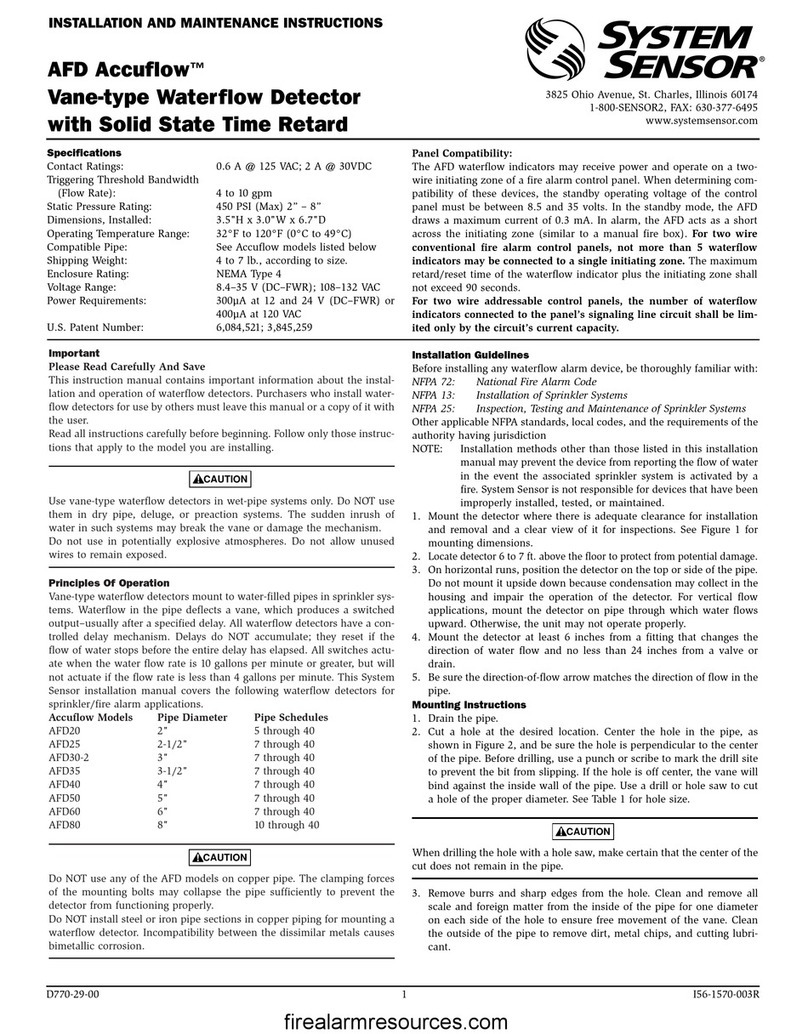
System Sensor
System Sensor AFD Accuflow Installation and maintenance instructions
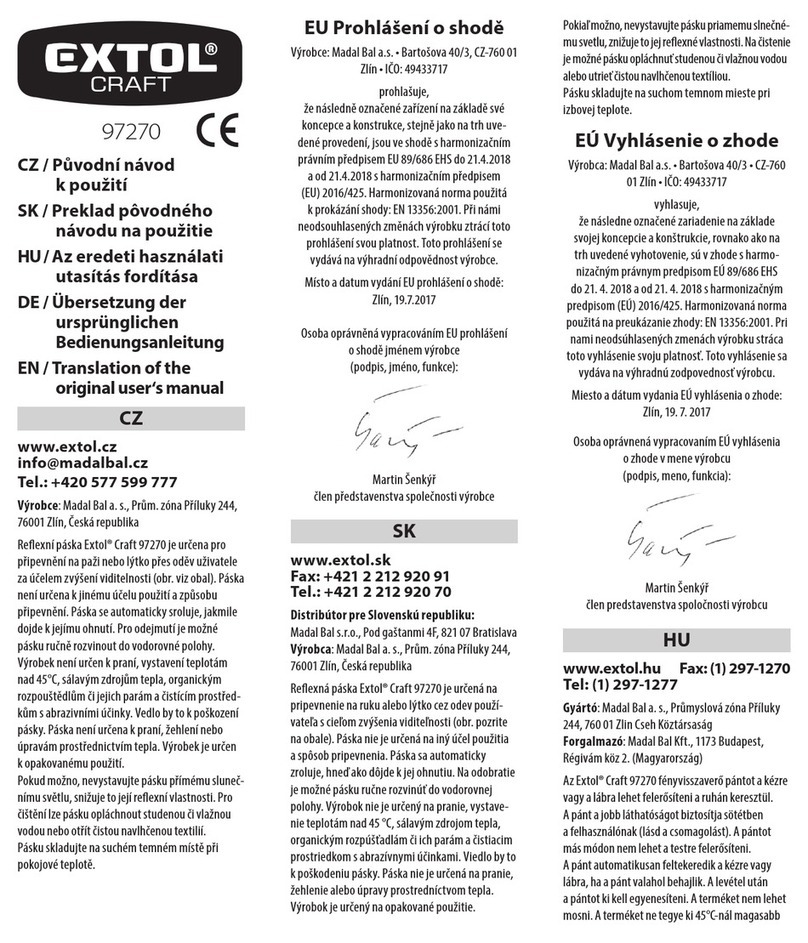
EXTOL Craft
EXTOL Craft 97270 user manual

TiTLEY Scientific
TiTLEY Scientific Anabat Scout user manual

Conrad
Conrad HZK202 operating instructions
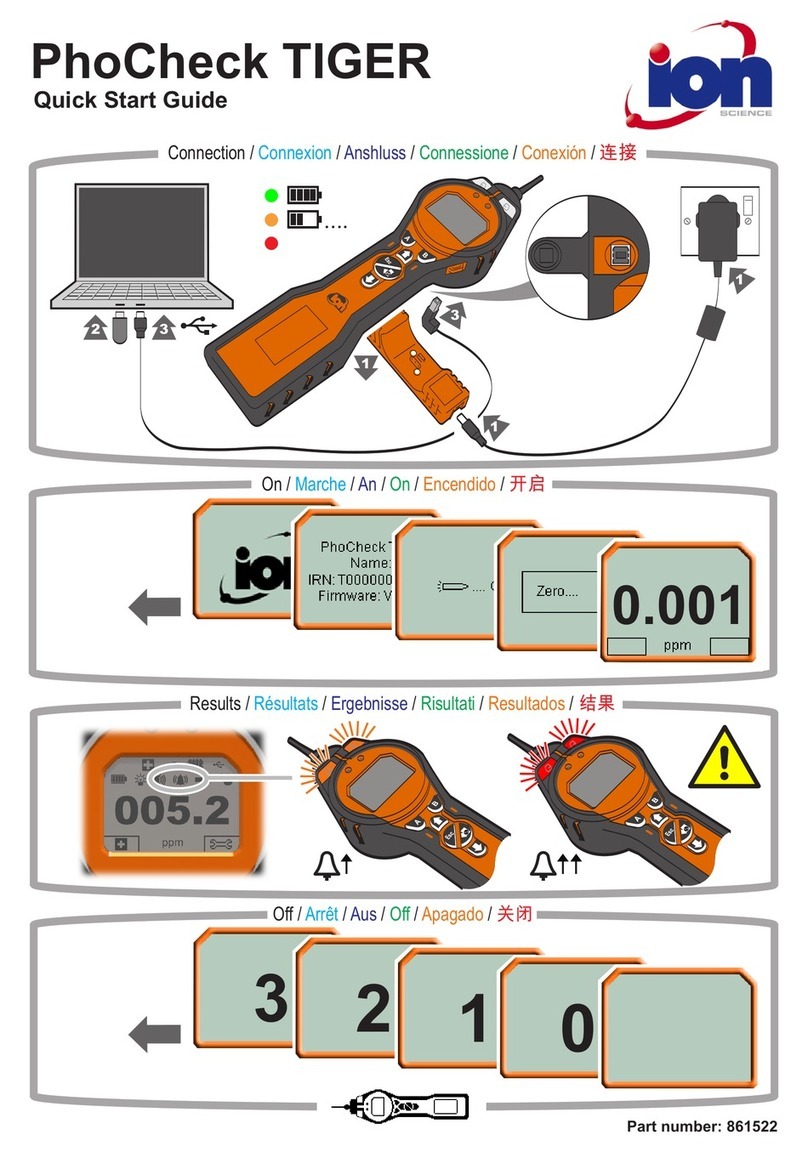
ion science
ion science PhoCheck TIGER quick start guide
Inficon
Inficon HLD6000 Translation of the original operating instructions
